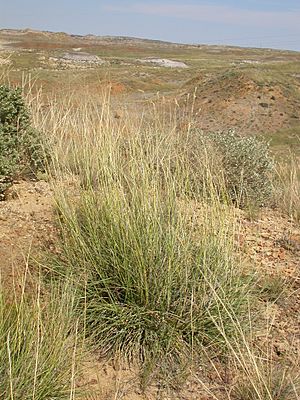Alkali sacaton facts for kids
Quick facts for kids Alkali sacaton |
|
|---|---|
 |
|
| Scientific classification | |
| Genus: |
Sporobolus
|
| Species: |
airoides
|
Sporobolus airoides is a type of grass often called alkali sacaton. It grows naturally in western North America. You can find it in the western United States, parts of Canada (like British Columbia and Alberta), and northern and central Mexico. This grass is special because it can grow in many different places, especially in alkali soils, which are soils with high salt content. For example, it thrives in the California desert regions.
Contents
What is Alkali Sacaton?
Alkali sacaton is a perennial bunchgrass. This means it lives for more than two years and grows in clumps. Its stems can grow up to 2 m (6.6 ft) (about 6.5 feet) tall. The bottom parts of the stems are thick and strong, almost like wood.
Its leaves are green or gray-green and can be as long as 60 cm (24 in) (about 2 feet). The plant's flowers grow in a long, open, and spreading cluster called an inflorescence. These flower parts have yellow spikelets (small flower clusters) with purplish bottoms. Alkali sacaton makes many seeds. These seeds often travel in water and start to grow when they settle into sediment (like mud or sand).
Growing in Salty Soil
Alkali sacaton is a special kind of plant called a halophyte. This means it can grow well in soils that have a lot of salt. It grows best when it's warm, sunny, and wet. This allows it to easily spread into salty areas, like alkali flats, when the ground is wet.
Why This Grass is Useful
This grass is very helpful for restoring natural areas. It is used in projects to bring back plants in places where the land has been disturbed. This is especially true in the Southwestern United States, particularly near rivers and streams (called riparian zones) in California and the Intermountain West.
Helping the Mojave Desert
Alkali sacaton is planted along with another grass called Muhlenbergia asperifolia (scratchgrass). They are used to restore areas along the Mojave River and other riverbanks in the Mojave Desert. Once it starts to grow, alkali sacaton creates a thick groundcover. This helps protect the soil and supports local wildlife.

